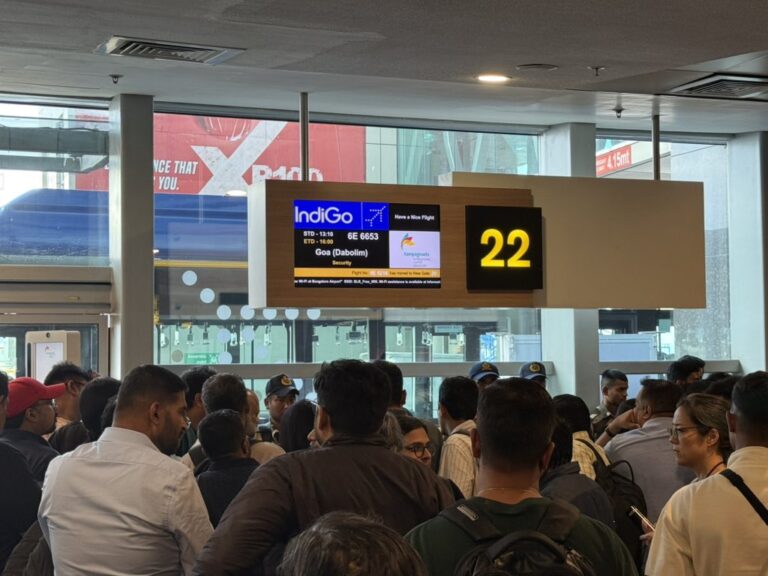
Hebbal Flyover, Bengaluru
Bengaluru: A long-kept secret was revealed by Sameer Nigam, CEO of PhonePe when he said that Kannadigas would not be given employment opportunities in his firm when the draft bill on job reservation was announced by the Karnataka government recently.
This is even though PhonePe was born in Bengaluru and making loads of money by using the high-end infrastructure, tax benefits and all other brand equity that this city is renowned for the world over. He had the guts and audacity to openly say, he would not employ the natives while other CEOs loudly clapped behind clandestinely. Later what happened to Sameer Nigam for his “false pride” comment at his boardroom meeting is well-known.
Not many know the fact, that in the last 10-12 years, there has been a tacit communication within all company HR Heads based out of Bengaluru not to employ/engage Kannadigas in their firms. The reason is not a lack of skill sets, but they just don’t want to employ basically to assuage their “false pride”, like Sameer Nigam.
On the other side, most company HR Heads are “outsiders”. Either he/she is a Bengali, Bihari, UPite, Malayali, Tamilan or a Maharashtrian. A Kannadiga rarely heads the Human Resources (HR) department in a big company. Hence, it comes “naturally” to them not to encourage native resumes, despite their possessing the requisite skill sets. This aspect explains the intake of a maximum number of “outsiders” when recruitments happen.
This can further be explained: Take any company: major, medium, small or just a start-up with a handful of employees; the Kannadiga intake is less than 5 per cent. And the major portion of that “employment” is restricted to say security guards, gardeners, hygiene workers, drivers, canteen service and the ilk or at the most coders, team leads and a few mid-level jobs.
What is surprising is the fact that several native industry heads themselves have openly said that Kannadigas lack skill sets and hence, they are coerced to hire from neighbouring states. This has further emboldened companies to source human capital from outside Karnataka. Even for argument’s sake if it is accepted, then how can one explain the fact that across the state, there are over two lakh engineers (of the 5-6 lakhs) with high proficiency levels, who graduate from various top-rated engineering colleges? Does that mean he/she is not qualified to be engaged in these companies and only ‘outsiders’ are more competent than the natives? On this count, several industry leaders, when questioned, have often dodged the question in several forums.
Yes, in a democracy, the right wrests with the recruiter to pick and choose as he/she is the rightful authority. But then does one not have some propriety and allegiance as to where you live, work and make money?
It is this battle and constant insult from the companies towards natives, that has forced the Karnataka Government to announce a job quota for the native population. This quota Bill was not drafted overnight. It went through several levels of discussions about the loss of local talents and the need to reinstate the Kannada pride. Can any state show the record that a higher percentage of non-locals are appointed like in Bengaluru? It is always the local talents that get the preference. If a company is unable to source a particular skill set only then they will look out for alternatives.
What is more intriguing is the fact that the companies where a few Kannadigas work, are looked upon as a kind of “pariah” and they do not allow them to speak in their native language. If he/she raises the voice, a pink slip follows.
Related to this aspect let me share a rough demographic change that has happened in Bengaluru over the last two decades and the level of destruction of this once “Garden City” and “Pensioners Paradise” due to the outsider population completely taking over every nook and corner of this city.
Out of the 1.40 crore population, almost 95 lakhs are outsiders. This is recorded in known statistics. Nobody knows, including the Government authorities, how many are entering Bengaluru daily for job and settling down. It is the 24th most populous city in the world. Out of more than 1 crore vehicles plying on Bengaluru roads, close to 40 lakh vehicles are non-Karnataka registered ones. Nowhere in the world, such a high number of outside vehicles are plying in a city.
What has this done to Bengaluru and its natives? And who is benefiting from this massive influx into the city?
According to several studies, Bengaluru is a dead city, as its infrastructure cannot sustain this massive growth. There is traffic densely plying almost 20 hours a day across the city. Air, water and sound pollution are causing medical issues for residents.
There is a severe water shortage and according to studies, water sources may dry up in a few years from now, leaving the local residents to flee from Bengaluru themselves.
The cost of living according to one study is equal to living in New York. Often reels are made mocking Bengaluru rent prices. Do they realise that the cost of living for the locals has risen over 100 times in two decades? At times money cannot even buy what the locals want, as there is a severe shortage of essentials due to high demand for the same. The locals are bearing the brunt which is not highlighted by anyone. More mouths to feed.
Daily, most of the people walk through the sanitary leakages on the main roads and bylanes, which was unheard of two decades ago. Over 92 per cent of the green cover that the city was renowned for, has vanished, as apartments and commercial buildings have come up, where only outsiders, not the locals reside. Bengaluru is also known for its 176 lakes, all interconnects have vanished with only 10 odd ones surviving, that too, due to pressure from the locals.
High-end apartments and commercial complexes have come up on these lake beds. Even a small drizzle is enough to flood their basements and the compound. Here too the outsiders make a huge hue and cry about their “pathetic living conditions”, failing to understand that this place was once a beautiful lake with over 100 migratory birds breeding their progenies for future sustenance. Almost all outsiders think that they own Bengaluru after buying a flat or a piece of land and behave in such a manner which creates a lot of skirmishes with locals.
Often the CEOs demand better infrastructure from Bengaluru city authorities saying they pay taxes and hence are entitled to better amenities. But they don’t talk about the collateral damage that Bengaluru is suffering day in and day out from these very people. The funniest part is that the apartment residents protest outside their dwelling to save a pond for their children to play, forgetting the fact that they have destroyed a pristine and breathing lake and built their apartment in the very same place they are residing. Similarly, they voice their concern with “Pani Chaiye Pani Chaiye” slogans forgetting the fact that they ruined an interlinking lake by building their dwelling on the very base they are staying which was once a great automatic source for ground water recharging for a century.
While talking of the ills and destruction of Bengaluru, we must also talk about who is making the fast buck out of this mad outsider rush to this city. The local politicians and ‘extended outsiders’ mafia are the actual beneficiaries and the culprits who are encouraging the influx into Bengaluru. The more the influx the more coffers fill for them since they control the real estate, water, transport, road construction, and food supplies. You name it they are the stakeholders. It is a continuous money flow for them which they do not want to forego so easily. That is the reason why the radical Job Quota Bill now stands withdrawn albeit temporarily. The invisible hands forced the Bill to be “junked”, as one prominent CEO stated.
Coming back to job quota issues, as a solution to decongest and stunt the growth of Bengaluru, the Karnataka Government started the “Beyond Bengaluru” initiative offering tax moratoriums, low-cost land, quality infrastructure and ready and specialised Human Capital in II-Tier cities. But none of the “red flag” companies even consider the option.
On the day of the announcement of the job quota in the Karnataka Assembly by Chief Minister Siddaramaiah, these known red flag companies raised a hue and cry and threatened to pack their bags from “Bengaluru” and move to neighbouring states. But when they were asked to openly leave Bengaluru the campaign died instantly.
The ‘junked’ Job Quota Bill insisted on giving prominence in job to local talents who are equally or more competent to handle assignments of any nature. If companies cannot source a specialised skill, only then they should opt for an alternative. On this front, the Karnataka government should not question and should wholeheartedly support the decision.
Several companies have already experienced exploring or even setting up bases in other states, but most regretted their decision, as they miserably failed in other states. There is no denying the fact that “Brand Bengaluru” cannot be replicated anywhere in the world.
*The author is associated with the IMS Foundation, the single largest collaborative platform of all Indian and global manufacturing entities showcasing the manufacturing capability and prowess of Indian companies to the global market. The views are personal.






